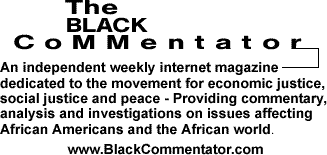
| Home |
Please Remember
My Sisters This Month!
Inclusion
By The Reverend Irene Monroe
BlackCommentator.com Editorial Board
Please remember my sisters this month!
Why?
December 1 is World AIDS Day and Black women are dying of AIDS. And is anyone doing anything about it?
Right here in the nation�s capitol, the HIV/AIDS
epidemic rivals that of many
Are these statistics overwhelming?
�The Washington data is really a microcosm of what we already know: that AIDS in America today is a black disease,� said Phil Wilson, founder of the Black AIDS Institute, an HIV/AIDS think tank that focuses exclusively on AIDS among black Americans.
According to the U.S. Centers for Disease Control
and Prevention, African Americans account for half of all new HIV cases
despite comprising 13 percent of the
At the �Women and Response to AIDS� panel at the at the 16th International AIDS Conference in Toronto in 2006, Sheila Johnson, founder of the Crump-Johnson Foundation in Washington D.C., pointed out that another at-risk population in the African American community is teenage girls.
Seventeen percent of the
When asked why such a high percentage test positive, Johnson said, �As long as girls see themselves as glorified sex objects in hip-hop videos, HIV/AIDS will increase within this population.�
Are these statistics overwhelming?!
But so too is the failure of leadership African Americans have faced since the epidemic began.
And no group of women is as affected by the failure of leadership in this country than women of African descent.
African American women and their struggle against the AIDS epidemic was never so glaringly obvious than in the 2004 vice presidential debate between Dick Cheney and John Edwards.
And the invisibility of my group�s plight has less
to do with African-American women�s agency to combat the epidemic than
with how the government, African-American men, the
Gwen Ifill, an African-American female journalist
with PBS� �Washington Week� and moderator of the vice presidential debate,
brought the issue of AIDS in the
�I want to talk to you about AIDS, and not about
AIDS in
Vice President Cheney responded to Ifill�s question
by saying, �Here in the
But Edwards� response wasn�t any better. Edwards deflected the question by first going back to answering the previous question. Then with the remaining seconds left, he flubbed his way through.
However, three years later, in the June 2007 Democratic Primary Debate at Howard University that focused on African American issues ranging from health care and housing to Katrina relief, the economy and the environment, Black women stood on their feet as they applauded Sen. Hillary Clinton�s comment about the impact of HIV/AIDS on African American women.
�Let me just put this in perspective: If HIV-AIDS were the leading cause of death of white women between the ages of 25 and 34 there would be an outraged outcry in this country.�
When the color of the epidemic shifted from white to black, the inherent gender bias focused only on the needs of African-American men and rendered women invisible. And when gender became a new lens to track the epidemic, white women were the focus. The invisibility of African-American women in this epidemic has much to do with how the absence of a gendered race analysis makes African-American women invisible to the larger society.
What is also unnerving is that today African American women make up 60 percent of all AIDS cases reported among women, 64 percent of new AIDS cases among women, and are three times the number of new cases reported among white women.
Many African-American women with HIV contracted it from heterosexual sex. And two ways that the virus is contracted heterosexually is through intravenous drug use and African-American men �on the down low.� But men living on the DL is not a new phenomenon in the African-American community. Naming it, however, is. And it was J.L. King who became the country�s poster boy by exposing the behavior in his best-seller, On the Down Low: A Journey into the Lives of 'Straight' Black Men Who Sleep with Men.
�There are many women, too many women, in relationships with men who they think they know but really don�t. He knew he had the disease, his mother knew he had the disease, his doctors knew, everyone seemed to know except me. And no one said a word,� LaJoyce Brookshire wrote in the foreword of Browder�s book, herself author of Faith Under Fire: Betrayed by a Thing Called Love.
While homophobic attitudes in the larger African-American community and church contribute to their behavior, African-American men are also not taking responsibility for how their behavior is killing African-American women, and putting the entire community at risk.
But the disparities within the healthcare system also contribute to the disproportionately higher number of HIV cases among African-American women, which directly affects their quality of life and the spread of HIV.
While health disparities in the black community are overwhelming, so too is the failure of leadership African Americans have faced since the epidemic began.
But Phil Wilson states it plainly:
�I think it�s important for us to take just a moment to realize that we are where we are today because we weren�t concerned when we thought it was somebody else�s disease,�
However, the disease has also taught us about the various faces - across race, class and gender - who wore and continue to wear the face of this disease.
When The New York Native, a now-defunct gay newspaper, in its May 18, 1981, issue first reported on a virus found in gay men then known as GRID (Gay-Related Immune Deficiency), an editorial noted that �even if the disease first became apparent in gay men, it is not just �a gay disease.�� And HIV/AIDS, having neither an alliance to nor an affinity for queer sexualities, spread.
But where would the leadership on HIV/AIDS come from?
But let�s confront the elephant in the black community, by telling the truth and shaming the devil. The biggest problem that black lawmakers have had to confront concerning the HIV/AIDS crisis in their communities is the political gag order imposed on them by their voting constituency�s homophobia and animus toward any discussion of the disease. Would the leadership on HIV/AIDS come from the black church?
When it comes to the black church and HIV/AIDS,
I am always reminded of what my mayor in
The
Therefore, women with AIDS are as unwelcome in the
The feminization of this disease makes many of us AIDS activists and scholars wonder if the same amount of money, concern, communication, and moral outrage that was put into white gay men with the disease will be put into curbing its spread among black women.
The AIDS epidemic among African-American women is also symptomatic of the dialogue we need to have about our bodies and sexuality, which has been choked for centuries by a �politic of silence.�
Working in conjunction with the �Politic of silence� is what African-American women historically created as a �culture of dissemblance� and �the politic of respectability,� the silence African-American women created around their bodies and sexuality that had been exploited during slavery was viewed as a revolutionary act against the white oppressive gaze.
African-American women are no more promiscuous than white women, however, stereotypes about African-American women�s bodies and sexualitities prevent the proper prevention and education needed to stem the tide of HIV/AIDS.
The iconography of black women is predicated on four racist cultural images: the Jezebel, the Sapphire, Aunt Jemima, and Mammy. With the image of the strong black women who can endure anything and �make a way out of no way,� her strength is either demonized as being emasculating of black men or impervious to the human condition. The Aunt Jemima and Mammy stereotypes are now conflated into what�s called �Big Mamma� in today�s present iconography of racist and sexist images of African-American women.
While the Aunt Jemima and Mammy stereotypes are prevalent images that derive from slavery, for centuries both of them have not only been threatening, comforting and nurturing to white culture but also to African-American men. The dominant culture doesn�t see and hear African-American voices on this issue because our humanity is distorted and made invisible through a prism of racist and sexist stereotypes. So, too, is our suffering.
BlackCommentator.com
Editorial Board member, the Rev. Irene Monroe, is a religion columnist,
theologian, and public speaker. A native of Brooklyn, Rev. Monroe is a
graduate from Wellesley College and Union Theological Seminary at Columbia
University, and served as a pastor at an African-American church before
coming to Harvard Divinity School for her doctorate as a Ford Fellow.
She was recently named to MSNBC�s list of 10 Black Women You Should Know. Reverend Monroe is
the author of Let Your Light Shine Like
a Rainbow Always: Meditations on Bible Prayers for Not-So-Everyday Moments
![]() .
As an African American feminist theologian, she speaks for a sector of
society that is frequently invisible. Her website is irenemonroe.com.
Click here
to contact the Rev. Monroe.
.
As an African American feminist theologian, she speaks for a sector of
society that is frequently invisible. Her website is irenemonroe.com.
Click here
to contact the Rev. Monroe.
| Home |


